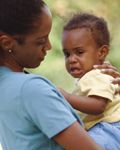A toddler with fever and a limp
A 17-month-old African-American girl is admitted for evaluation of fever and a limp. She is diagnosed positive for an unexpected pathogen, Kingella kingae.

Before entering the patient's room, you quickly check her chart in your electronic medical record noting that she has had a fever as high as 104.4° F (40.2° C) for the past five days, and she has been limping for three days in the right-lower extremity (RLE). In reviewing the chart, you notice that your practice partner had obtained a three-phase bone scan of the patient's RLE. You decide to look at the results after examining the patient.
As you walk into the patient's room, you observe the mother and the father standing around the patient's bed, looking very worried. To your surprise, though, the patient appears completely unconcerned. She is sitting up, covered with stickers, and is plastering more stickers on her companion, Elmo. She looks up at you briefly before getting back to the task at hand.
You introduce yourself, and ask the parents about the child's current illness. They say she has generally been healthy, with nothing more significant than occasional viral infections, none of which were recent.
The parents state that their daughter has become increasingly fussy over the past week, but was consoled when held. She then developed a fever and limp, and her right foot became slightly swollen. While she will play sitting down, she refuses to stand or walk.
In addition, the mother mentions that the patient developed a rash on the third day of her fever, but that the rash resolved after two days. The patient has not developed swelling of any other joints, nor has she ever had similar symptoms before.
Patient history
Recalling a recent patient with leukemia who also presented like this, you ask about recent weight loss or lack of weight gain, both of which are negative. You ask about the patient's regular activities: she attends day care regularly on weekdays, has not traveled anywhere recently, and has neither significant outdoor exposures nor any recent history of trauma.
Knowing that tuberculosis can occasionally present with vague, unusual symptoms, you also make sure to ask about other possible risk factors.
The parents state that the child's appetite has been slightly decreased over the past week, but she has been drinking the same amount of fluids as usual. Her urine output is normal-about four wet diapers a day. She has had no change in her bowel habits.
Inquiring into the patient's past history, you find that her mother had an uncomplicated pregnancy, with the exception of diet-controlled gestational diabetes. Her daughter was born via spontaneous vaginal delivery at 6 lbs. 5 oz. She met appropriate developmental milestones, and has had all her appropriate immunizations.
Inquiring into the family history, you find that the mother is affected by multiple sclerosis. There was no history of children dying at an early age, and no history of brittle bone disease (osteogenesis imperfecta.) The parents have been treating their child's fever with ibuprofin; she is on no other medications.
Developing an index of suspicion
The differential at this point is quite broad, but you make a list of important possibilities which you would like to rule out. High on your index of suspicion is a septic, inflamed joint. However, the patient does not appear in as bad of a condition as one would expect for that condition. Among other infectious causes, you also think of osteomyelitis, which may be slightly more consistent with the patient's presentation. A fracture could be a very likely possibility, with an unrelated infection causing the fever. Toxic synovitis, a generally benign process in children that usually presents with hip pain, limping, and low-grade fever, is also on your differential.